The Benefits of Employee Training and Development: Iceland Food Ltd
VerifiedAdded on 2019/12/03
|20
|5246
|215
Report
AI Summary
This report presents a research proposal and subsequent findings on the benefits of employee training and continuous development within Iceland Food Ltd, a UK-based retail food organization. The study aims to evaluate the impact of training on employee attitude, assess the significance of continuous development, and recommend improvements to training strategies. The research employs a quantitative approach with convenience sampling, focusing on the retail sector and addressing issues of unskilled labor and its effect on productivity. The report includes a literature review, methodological framework, and analysis of the time plan, ethical considerations, and challenges encountered. The key findings highlight the importance of training in enhancing employee engagement, motivation, retention, and overall attitude, emphasizing the need for tailored training modules to improve employee performance and contribute to organizational goals. The study offers insights for managers, research scholars, and students in the field of human resource management and the retail industry.
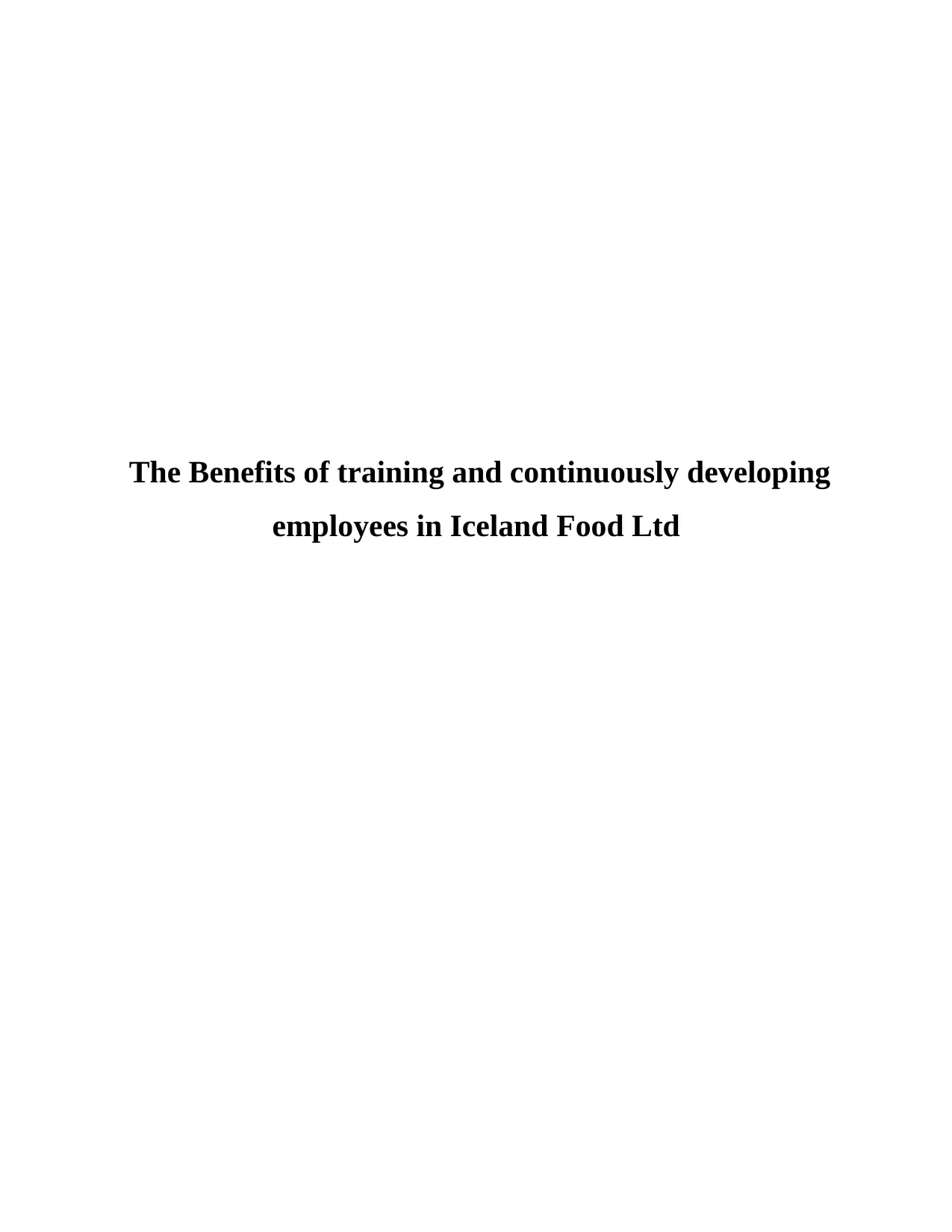
The Benefits of training and continuously developing
employees in Iceland Food Ltd
employees in Iceland Food Ltd
Paraphrase This Document
Need a fresh take? Get an instant paraphrase of this document with our AI Paraphraser
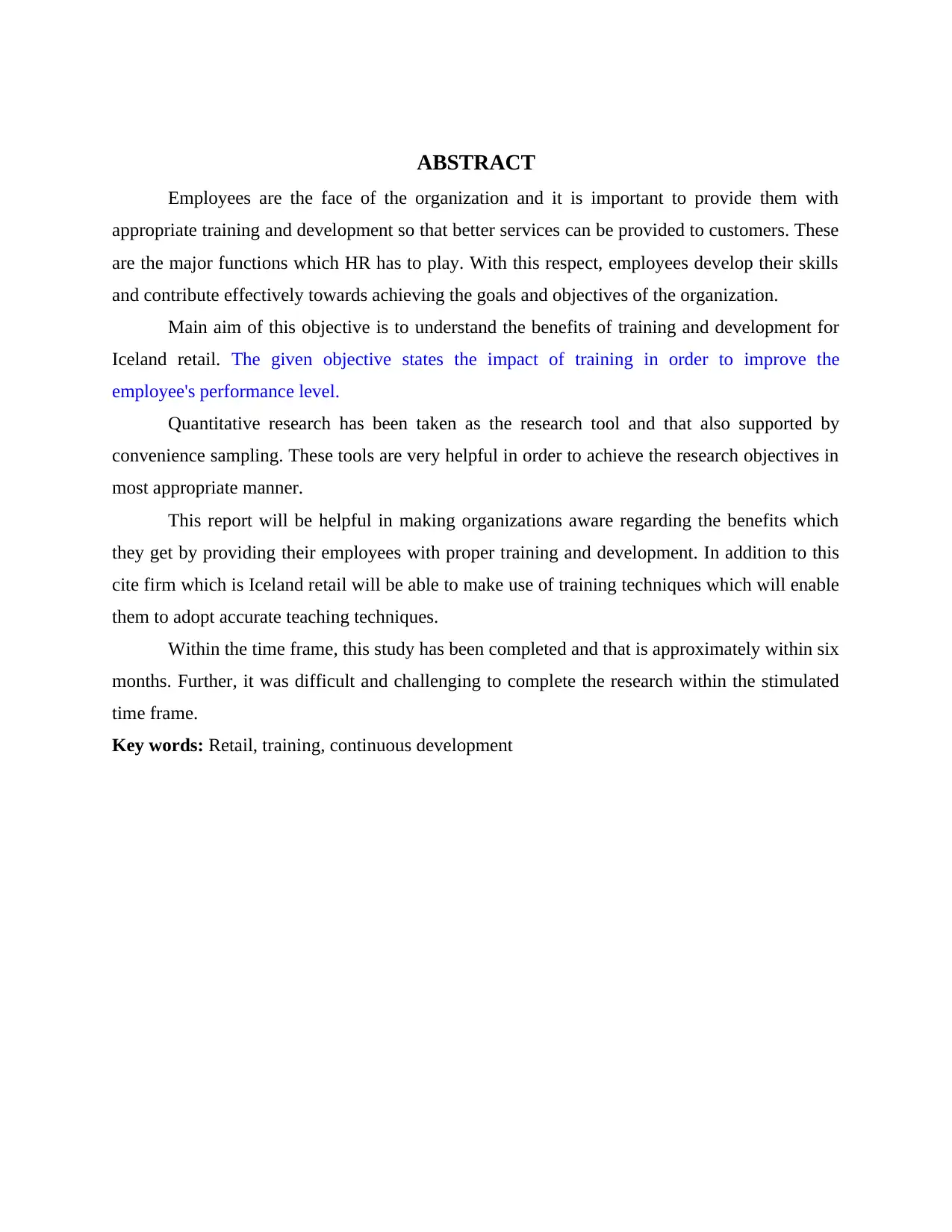
ABSTRACT
Employees are the face of the organization and it is important to provide them with
appropriate training and development so that better services can be provided to customers. These
are the major functions which HR has to play. With this respect, employees develop their skills
and contribute effectively towards achieving the goals and objectives of the organization.
Main aim of this objective is to understand the benefits of training and development for
Iceland retail. The given objective states the impact of training in order to improve the
employee's performance level.
Quantitative research has been taken as the research tool and that also supported by
convenience sampling. These tools are very helpful in order to achieve the research objectives in
most appropriate manner.
This report will be helpful in making organizations aware regarding the benefits which
they get by providing their employees with proper training and development. In addition to this
cite firm which is Iceland retail will be able to make use of training techniques which will enable
them to adopt accurate teaching techniques.
Within the time frame, this study has been completed and that is approximately within six
months. Further, it was difficult and challenging to complete the research within the stimulated
time frame.
Key words: Retail, training, continuous development
Employees are the face of the organization and it is important to provide them with
appropriate training and development so that better services can be provided to customers. These
are the major functions which HR has to play. With this respect, employees develop their skills
and contribute effectively towards achieving the goals and objectives of the organization.
Main aim of this objective is to understand the benefits of training and development for
Iceland retail. The given objective states the impact of training in order to improve the
employee's performance level.
Quantitative research has been taken as the research tool and that also supported by
convenience sampling. These tools are very helpful in order to achieve the research objectives in
most appropriate manner.
This report will be helpful in making organizations aware regarding the benefits which
they get by providing their employees with proper training and development. In addition to this
cite firm which is Iceland retail will be able to make use of training techniques which will enable
them to adopt accurate teaching techniques.
Within the time frame, this study has been completed and that is approximately within six
months. Further, it was difficult and challenging to complete the research within the stimulated
time frame.
Key words: Retail, training, continuous development
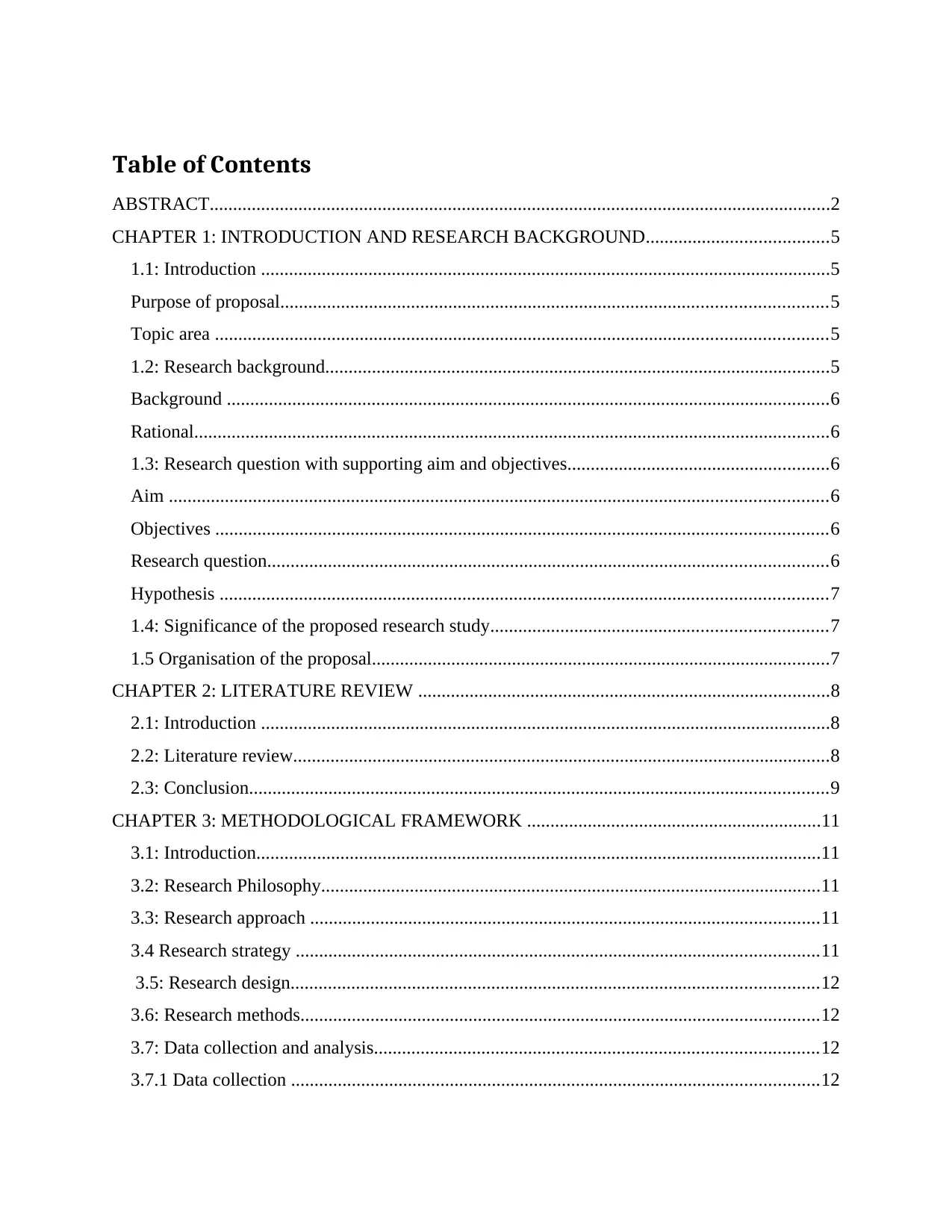
Table of Contents
ABSTRACT.....................................................................................................................................2
CHAPTER 1: INTRODUCTION AND RESEARCH BACKGROUND.......................................5
1.1: Introduction ..........................................................................................................................5
Purpose of proposal.....................................................................................................................5
Topic area ...................................................................................................................................5
1.2: Research background............................................................................................................5
Background .................................................................................................................................6
Rational........................................................................................................................................6
1.3: Research question with supporting aim and objectives........................................................6
Aim .............................................................................................................................................6
Objectives ...................................................................................................................................6
Research question........................................................................................................................6
Hypothesis ..................................................................................................................................7
1.4: Significance of the proposed research study........................................................................7
1.5 Organisation of the proposal..................................................................................................7
CHAPTER 2: LITERATURE REVIEW ........................................................................................8
2.1: Introduction ..........................................................................................................................8
2.2: Literature review...................................................................................................................8
2.3: Conclusion............................................................................................................................9
CHAPTER 3: METHODOLOGICAL FRAMEWORK ...............................................................11
3.1: Introduction.........................................................................................................................11
3.2: Research Philosophy...........................................................................................................11
3.3: Research approach .............................................................................................................11
3.4 Research strategy ................................................................................................................11
3.5: Research design.................................................................................................................12
3.6: Research methods...............................................................................................................12
3.7: Data collection and analysis...............................................................................................12
3.7.1 Data collection .................................................................................................................12
ABSTRACT.....................................................................................................................................2
CHAPTER 1: INTRODUCTION AND RESEARCH BACKGROUND.......................................5
1.1: Introduction ..........................................................................................................................5
Purpose of proposal.....................................................................................................................5
Topic area ...................................................................................................................................5
1.2: Research background............................................................................................................5
Background .................................................................................................................................6
Rational........................................................................................................................................6
1.3: Research question with supporting aim and objectives........................................................6
Aim .............................................................................................................................................6
Objectives ...................................................................................................................................6
Research question........................................................................................................................6
Hypothesis ..................................................................................................................................7
1.4: Significance of the proposed research study........................................................................7
1.5 Organisation of the proposal..................................................................................................7
CHAPTER 2: LITERATURE REVIEW ........................................................................................8
2.1: Introduction ..........................................................................................................................8
2.2: Literature review...................................................................................................................8
2.3: Conclusion............................................................................................................................9
CHAPTER 3: METHODOLOGICAL FRAMEWORK ...............................................................11
3.1: Introduction.........................................................................................................................11
3.2: Research Philosophy...........................................................................................................11
3.3: Research approach .............................................................................................................11
3.4 Research strategy ................................................................................................................11
3.5: Research design.................................................................................................................12
3.6: Research methods...............................................................................................................12
3.7: Data collection and analysis...............................................................................................12
3.7.1 Data collection .................................................................................................................12
⊘ This is a preview!⊘
Do you want full access?
Subscribe today to unlock all pages.

Trusted by 1+ million students worldwide
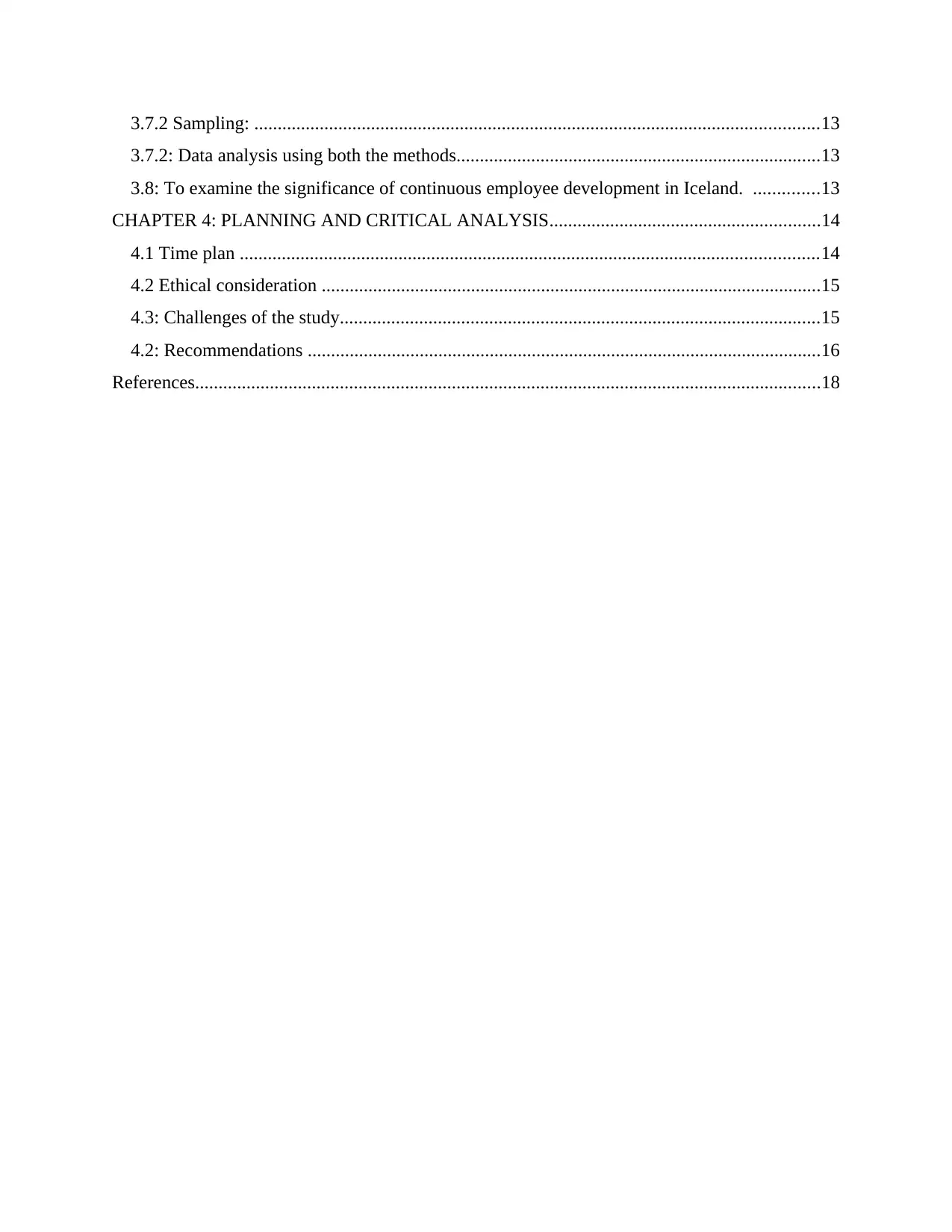
3.7.2 Sampling: .........................................................................................................................13
3.7.2: Data analysis using both the methods..............................................................................13
3.8: To examine the significance of continuous employee development in Iceland. ..............13
CHAPTER 4: PLANNING AND CRITICAL ANALYSIS..........................................................14
4.1 Time plan ............................................................................................................................14
4.2 Ethical consideration ...........................................................................................................15
4.3: Challenges of the study.......................................................................................................15
4.2: Recommendations ..............................................................................................................16
References......................................................................................................................................18
3.7.2: Data analysis using both the methods..............................................................................13
3.8: To examine the significance of continuous employee development in Iceland. ..............13
CHAPTER 4: PLANNING AND CRITICAL ANALYSIS..........................................................14
4.1 Time plan ............................................................................................................................14
4.2 Ethical consideration ...........................................................................................................15
4.3: Challenges of the study.......................................................................................................15
4.2: Recommendations ..............................................................................................................16
References......................................................................................................................................18
Paraphrase This Document
Need a fresh take? Get an instant paraphrase of this document with our AI Paraphraser
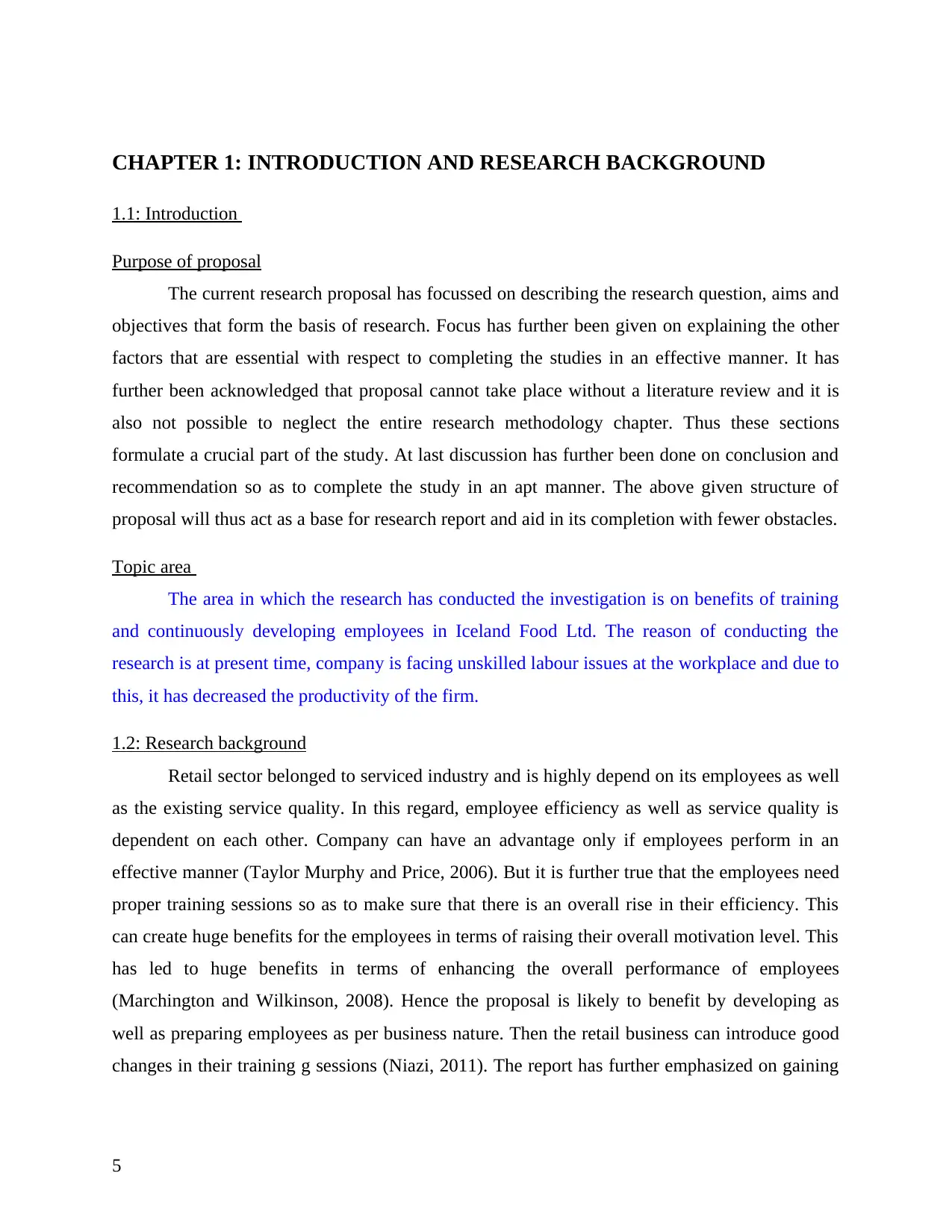
CHAPTER 1: INTRODUCTION AND RESEARCH BACKGROUND
1.1: Introduction
Purpose of proposal
The current research proposal has focussed on describing the research question, aims and
objectives that form the basis of research. Focus has further been given on explaining the other
factors that are essential with respect to completing the studies in an effective manner. It has
further been acknowledged that proposal cannot take place without a literature review and it is
also not possible to neglect the entire research methodology chapter. Thus these sections
formulate a crucial part of the study. At last discussion has further been done on conclusion and
recommendation so as to complete the study in an apt manner. The above given structure of
proposal will thus act as a base for research report and aid in its completion with fewer obstacles.
Topic area
The area in which the research has conducted the investigation is on benefits of training
and continuously developing employees in Iceland Food Ltd. The reason of conducting the
research is at present time, company is facing unskilled labour issues at the workplace and due to
this, it has decreased the productivity of the firm.
1.2: Research background
Retail sector belonged to serviced industry and is highly depend on its employees as well
as the existing service quality. In this regard, employee efficiency as well as service quality is
dependent on each other. Company can have an advantage only if employees perform in an
effective manner (Taylor Murphy and Price, 2006). But it is further true that the employees need
proper training sessions so as to make sure that there is an overall rise in their efficiency. This
can create huge benefits for the employees in terms of raising their overall motivation level. This
has led to huge benefits in terms of enhancing the overall performance of employees
(Marchington and Wilkinson, 2008). Hence the proposal is likely to benefit by developing as
well as preparing employees as per business nature. Then the retail business can introduce good
changes in their training g sessions (Niazi, 2011). The report has further emphasized on gaining
5
1.1: Introduction
Purpose of proposal
The current research proposal has focussed on describing the research question, aims and
objectives that form the basis of research. Focus has further been given on explaining the other
factors that are essential with respect to completing the studies in an effective manner. It has
further been acknowledged that proposal cannot take place without a literature review and it is
also not possible to neglect the entire research methodology chapter. Thus these sections
formulate a crucial part of the study. At last discussion has further been done on conclusion and
recommendation so as to complete the study in an apt manner. The above given structure of
proposal will thus act as a base for research report and aid in its completion with fewer obstacles.
Topic area
The area in which the research has conducted the investigation is on benefits of training
and continuously developing employees in Iceland Food Ltd. The reason of conducting the
research is at present time, company is facing unskilled labour issues at the workplace and due to
this, it has decreased the productivity of the firm.
1.2: Research background
Retail sector belonged to serviced industry and is highly depend on its employees as well
as the existing service quality. In this regard, employee efficiency as well as service quality is
dependent on each other. Company can have an advantage only if employees perform in an
effective manner (Taylor Murphy and Price, 2006). But it is further true that the employees need
proper training sessions so as to make sure that there is an overall rise in their efficiency. This
can create huge benefits for the employees in terms of raising their overall motivation level. This
has led to huge benefits in terms of enhancing the overall performance of employees
(Marchington and Wilkinson, 2008). Hence the proposal is likely to benefit by developing as
well as preparing employees as per business nature. Then the retail business can introduce good
changes in their training g sessions (Niazi, 2011). The report has further emphasized on gaining
5
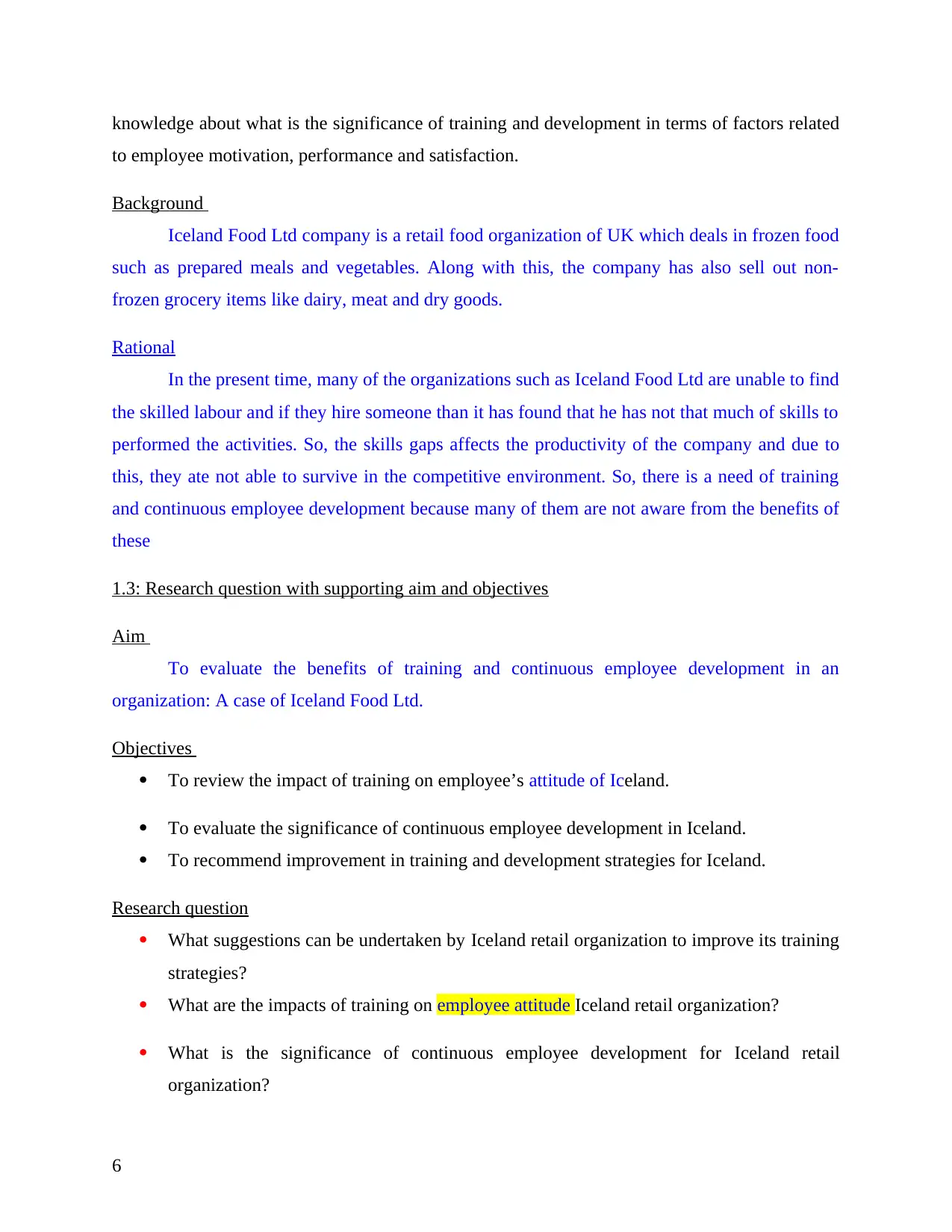
knowledge about what is the significance of training and development in terms of factors related
to employee motivation, performance and satisfaction.
Background
Iceland Food Ltd company is a retail food organization of UK which deals in frozen food
such as prepared meals and vegetables. Along with this, the company has also sell out non-
frozen grocery items like dairy, meat and dry goods.
Rational
In the present time, many of the organizations such as Iceland Food Ltd are unable to find
the skilled labour and if they hire someone than it has found that he has not that much of skills to
performed the activities. So, the skills gaps affects the productivity of the company and due to
this, they ate not able to survive in the competitive environment. So, there is a need of training
and continuous employee development because many of them are not aware from the benefits of
these
1.3: Research question with supporting aim and objectives
Aim
To evaluate the benefits of training and continuous employee development in an
organization: A case of Iceland Food Ltd.
Objectives
To review the impact of training on employee’s attitude of Iceland.
To evaluate the significance of continuous employee development in Iceland.
To recommend improvement in training and development strategies for Iceland.
Research question
What suggestions can be undertaken by Iceland retail organization to improve its training
strategies?
What are the impacts of training on employee attitude Iceland retail organization?
What is the significance of continuous employee development for Iceland retail
organization?
6
to employee motivation, performance and satisfaction.
Background
Iceland Food Ltd company is a retail food organization of UK which deals in frozen food
such as prepared meals and vegetables. Along with this, the company has also sell out non-
frozen grocery items like dairy, meat and dry goods.
Rational
In the present time, many of the organizations such as Iceland Food Ltd are unable to find
the skilled labour and if they hire someone than it has found that he has not that much of skills to
performed the activities. So, the skills gaps affects the productivity of the company and due to
this, they ate not able to survive in the competitive environment. So, there is a need of training
and continuous employee development because many of them are not aware from the benefits of
these
1.3: Research question with supporting aim and objectives
Aim
To evaluate the benefits of training and continuous employee development in an
organization: A case of Iceland Food Ltd.
Objectives
To review the impact of training on employee’s attitude of Iceland.
To evaluate the significance of continuous employee development in Iceland.
To recommend improvement in training and development strategies for Iceland.
Research question
What suggestions can be undertaken by Iceland retail organization to improve its training
strategies?
What are the impacts of training on employee attitude Iceland retail organization?
What is the significance of continuous employee development for Iceland retail
organization?
6
⊘ This is a preview!⊘
Do you want full access?
Subscribe today to unlock all pages.

Trusted by 1+ million students worldwide
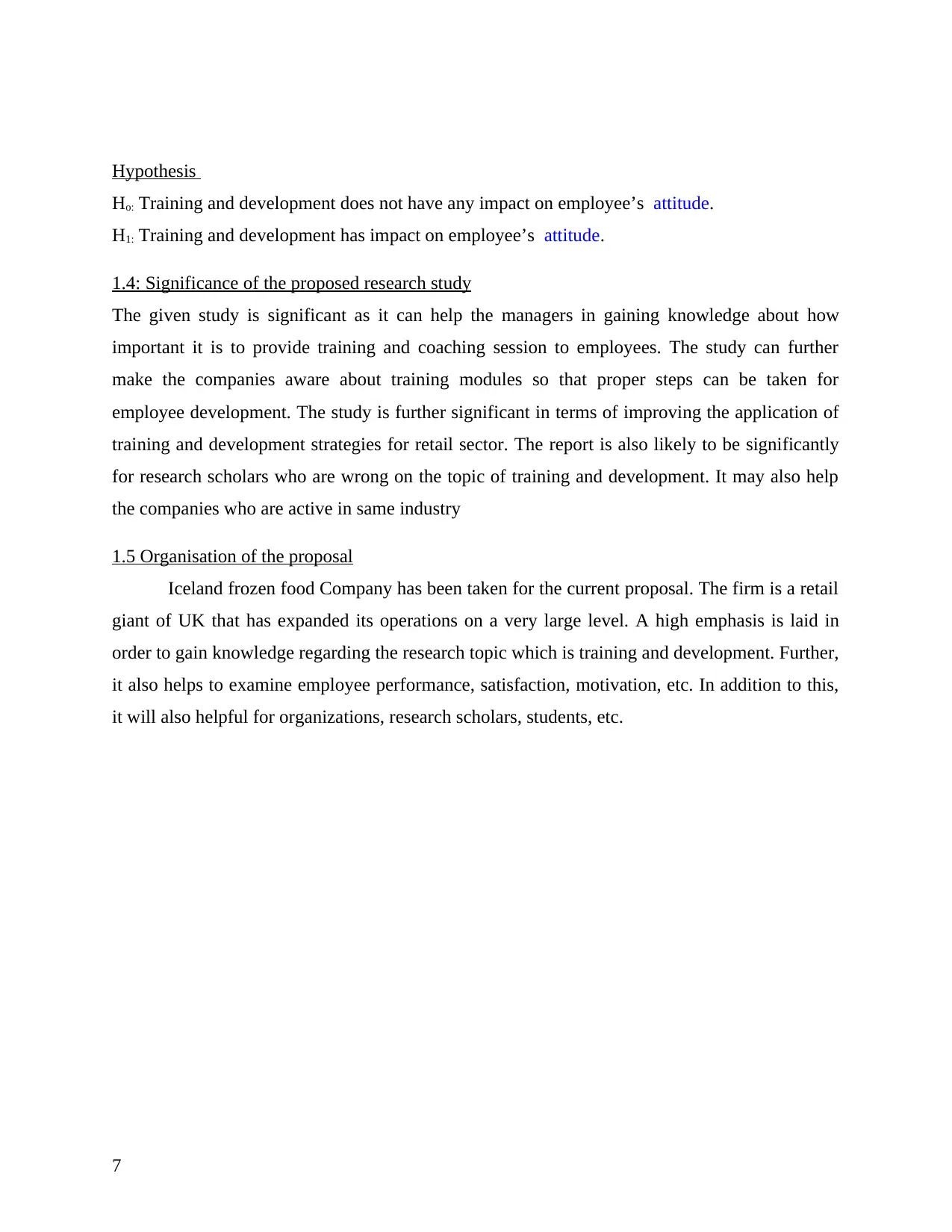
Hypothesis
Ho: Training and development does not have any impact on employee’s attitude.
H1: Training and development has impact on employee’s attitude.
1.4: Significance of the proposed research study
The given study is significant as it can help the managers in gaining knowledge about how
important it is to provide training and coaching session to employees. The study can further
make the companies aware about training modules so that proper steps can be taken for
employee development. The study is further significant in terms of improving the application of
training and development strategies for retail sector. The report is also likely to be significantly
for research scholars who are wrong on the topic of training and development. It may also help
the companies who are active in same industry
1.5 Organisation of the proposal
Iceland frozen food Company has been taken for the current proposal. The firm is a retail
giant of UK that has expanded its operations on a very large level. A high emphasis is laid in
order to gain knowledge regarding the research topic which is training and development. Further,
it also helps to examine employee performance, satisfaction, motivation, etc. In addition to this,
it will also helpful for organizations, research scholars, students, etc.
7
Ho: Training and development does not have any impact on employee’s attitude.
H1: Training and development has impact on employee’s attitude.
1.4: Significance of the proposed research study
The given study is significant as it can help the managers in gaining knowledge about how
important it is to provide training and coaching session to employees. The study can further
make the companies aware about training modules so that proper steps can be taken for
employee development. The study is further significant in terms of improving the application of
training and development strategies for retail sector. The report is also likely to be significantly
for research scholars who are wrong on the topic of training and development. It may also help
the companies who are active in same industry
1.5 Organisation of the proposal
Iceland frozen food Company has been taken for the current proposal. The firm is a retail
giant of UK that has expanded its operations on a very large level. A high emphasis is laid in
order to gain knowledge regarding the research topic which is training and development. Further,
it also helps to examine employee performance, satisfaction, motivation, etc. In addition to this,
it will also helpful for organizations, research scholars, students, etc.
7
Paraphrase This Document
Need a fresh take? Get an instant paraphrase of this document with our AI Paraphraser
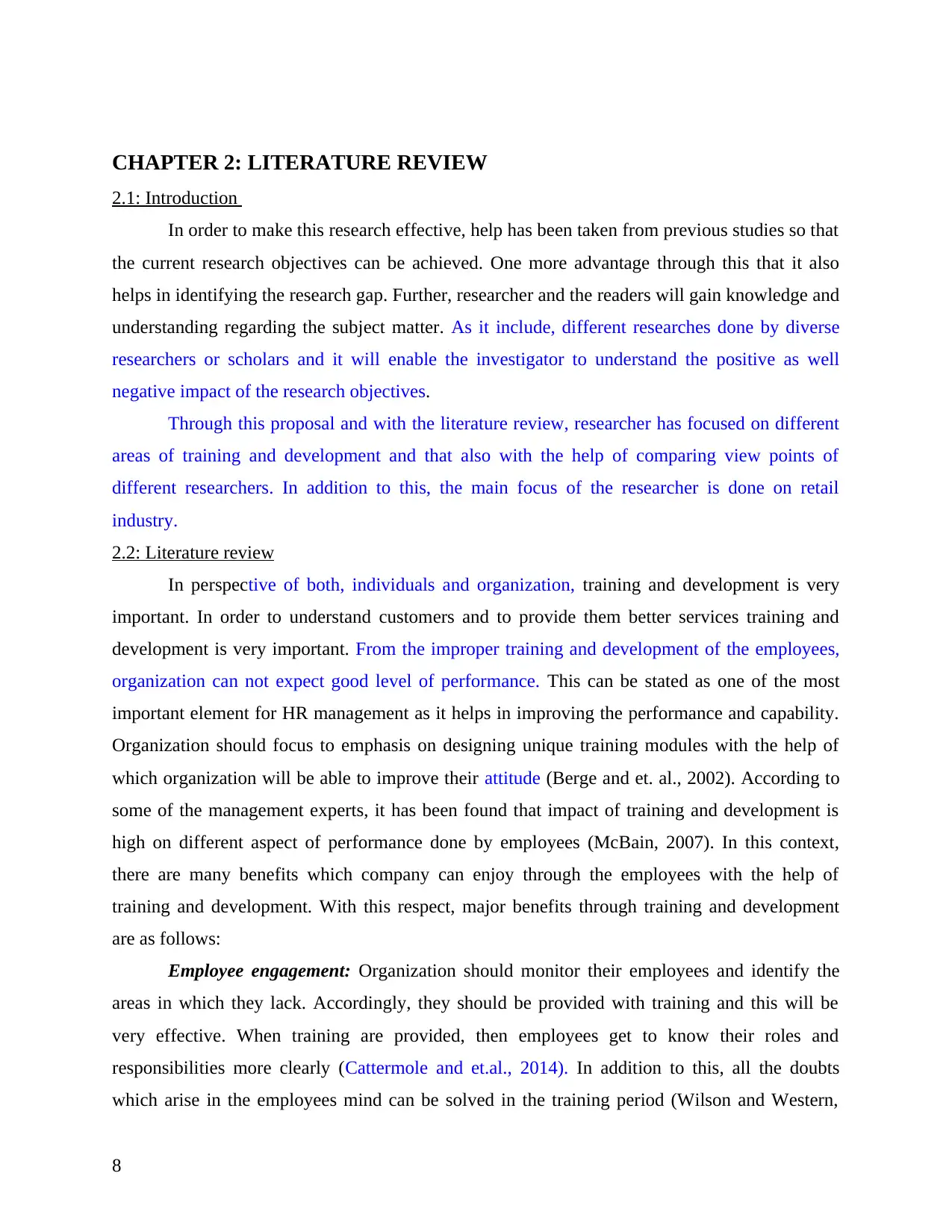
CHAPTER 2: LITERATURE REVIEW
2.1: Introduction
In order to make this research effective, help has been taken from previous studies so that
the current research objectives can be achieved. One more advantage through this that it also
helps in identifying the research gap. Further, researcher and the readers will gain knowledge and
understanding regarding the subject matter. As it include, different researches done by diverse
researchers or scholars and it will enable the investigator to understand the positive as well
negative impact of the research objectives.
Through this proposal and with the literature review, researcher has focused on different
areas of training and development and that also with the help of comparing view points of
different researchers. In addition to this, the main focus of the researcher is done on retail
industry.
2.2: Literature review
In perspective of both, individuals and organization, training and development is very
important. In order to understand customers and to provide them better services training and
development is very important. From the improper training and development of the employees,
organization can not expect good level of performance. This can be stated as one of the most
important element for HR management as it helps in improving the performance and capability.
Organization should focus to emphasis on designing unique training modules with the help of
which organization will be able to improve their attitude (Berge and et. al., 2002). According to
some of the management experts, it has been found that impact of training and development is
high on different aspect of performance done by employees (McBain, 2007). In this context,
there are many benefits which company can enjoy through the employees with the help of
training and development. With this respect, major benefits through training and development
are as follows:
Employee engagement: Organization should monitor their employees and identify the
areas in which they lack. Accordingly, they should be provided with training and this will be
very effective. When training are provided, then employees get to know their roles and
responsibilities more clearly (Cattermole and et.al., 2014). In addition to this, all the doubts
which arise in the employees mind can be solved in the training period (Wilson and Western,
8
2.1: Introduction
In order to make this research effective, help has been taken from previous studies so that
the current research objectives can be achieved. One more advantage through this that it also
helps in identifying the research gap. Further, researcher and the readers will gain knowledge and
understanding regarding the subject matter. As it include, different researches done by diverse
researchers or scholars and it will enable the investigator to understand the positive as well
negative impact of the research objectives.
Through this proposal and with the literature review, researcher has focused on different
areas of training and development and that also with the help of comparing view points of
different researchers. In addition to this, the main focus of the researcher is done on retail
industry.
2.2: Literature review
In perspective of both, individuals and organization, training and development is very
important. In order to understand customers and to provide them better services training and
development is very important. From the improper training and development of the employees,
organization can not expect good level of performance. This can be stated as one of the most
important element for HR management as it helps in improving the performance and capability.
Organization should focus to emphasis on designing unique training modules with the help of
which organization will be able to improve their attitude (Berge and et. al., 2002). According to
some of the management experts, it has been found that impact of training and development is
high on different aspect of performance done by employees (McBain, 2007). In this context,
there are many benefits which company can enjoy through the employees with the help of
training and development. With this respect, major benefits through training and development
are as follows:
Employee engagement: Organization should monitor their employees and identify the
areas in which they lack. Accordingly, they should be provided with training and this will be
very effective. When training are provided, then employees get to know their roles and
responsibilities more clearly (Cattermole and et.al., 2014). In addition to this, all the doubts
which arise in the employees mind can be solved in the training period (Wilson and Western,
8
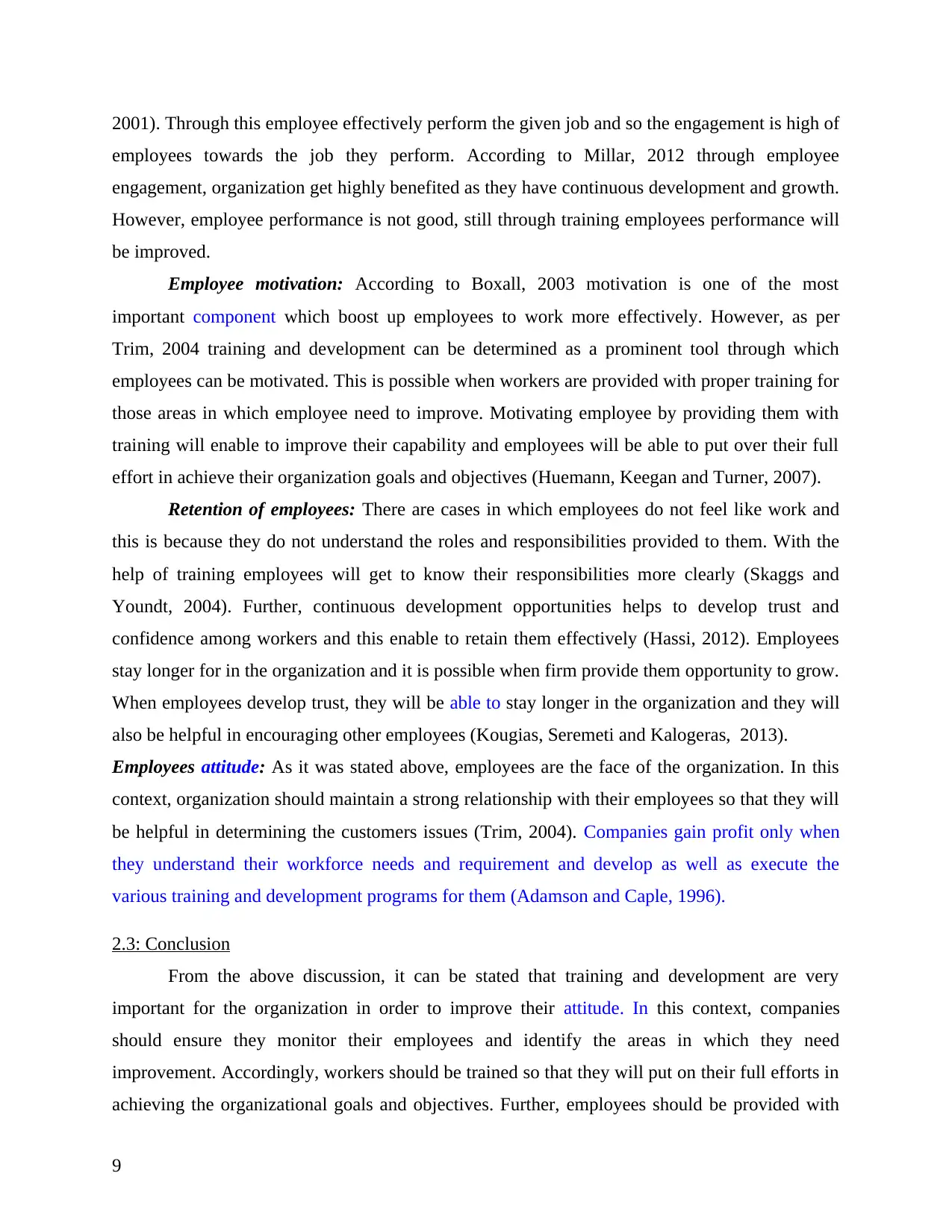
2001). Through this employee effectively perform the given job and so the engagement is high of
employees towards the job they perform. According to Millar, 2012 through employee
engagement, organization get highly benefited as they have continuous development and growth.
However, employee performance is not good, still through training employees performance will
be improved.
Employee motivation: According to Boxall, 2003 motivation is one of the most
important component which boost up employees to work more effectively. However, as per
Trim, 2004 training and development can be determined as a prominent tool through which
employees can be motivated. This is possible when workers are provided with proper training for
those areas in which employee need to improve. Motivating employee by providing them with
training will enable to improve their capability and employees will be able to put over their full
effort in achieve their organization goals and objectives (Huemann, Keegan and Turner, 2007).
Retention of employees: There are cases in which employees do not feel like work and
this is because they do not understand the roles and responsibilities provided to them. With the
help of training employees will get to know their responsibilities more clearly (Skaggs and
Youndt, 2004). Further, continuous development opportunities helps to develop trust and
confidence among workers and this enable to retain them effectively (Hassi, 2012). Employees
stay longer for in the organization and it is possible when firm provide them opportunity to grow.
When employees develop trust, they will be able to stay longer in the organization and they will
also be helpful in encouraging other employees (Kougias, Seremeti and Kalogeras, 2013).
Employees attitude: As it was stated above, employees are the face of the organization. In this
context, organization should maintain a strong relationship with their employees so that they will
be helpful in determining the customers issues (Trim, 2004). Companies gain profit only when
they understand their workforce needs and requirement and develop as well as execute the
various training and development programs for them (Adamson and Caple, 1996).
2.3: Conclusion
From the above discussion, it can be stated that training and development are very
important for the organization in order to improve their attitude. In this context, companies
should ensure they monitor their employees and identify the areas in which they need
improvement. Accordingly, workers should be trained so that they will put on their full efforts in
achieving the organizational goals and objectives. Further, employees should be provided with
9
employees towards the job they perform. According to Millar, 2012 through employee
engagement, organization get highly benefited as they have continuous development and growth.
However, employee performance is not good, still through training employees performance will
be improved.
Employee motivation: According to Boxall, 2003 motivation is one of the most
important component which boost up employees to work more effectively. However, as per
Trim, 2004 training and development can be determined as a prominent tool through which
employees can be motivated. This is possible when workers are provided with proper training for
those areas in which employee need to improve. Motivating employee by providing them with
training will enable to improve their capability and employees will be able to put over their full
effort in achieve their organization goals and objectives (Huemann, Keegan and Turner, 2007).
Retention of employees: There are cases in which employees do not feel like work and
this is because they do not understand the roles and responsibilities provided to them. With the
help of training employees will get to know their responsibilities more clearly (Skaggs and
Youndt, 2004). Further, continuous development opportunities helps to develop trust and
confidence among workers and this enable to retain them effectively (Hassi, 2012). Employees
stay longer for in the organization and it is possible when firm provide them opportunity to grow.
When employees develop trust, they will be able to stay longer in the organization and they will
also be helpful in encouraging other employees (Kougias, Seremeti and Kalogeras, 2013).
Employees attitude: As it was stated above, employees are the face of the organization. In this
context, organization should maintain a strong relationship with their employees so that they will
be helpful in determining the customers issues (Trim, 2004). Companies gain profit only when
they understand their workforce needs and requirement and develop as well as execute the
various training and development programs for them (Adamson and Caple, 1996).
2.3: Conclusion
From the above discussion, it can be stated that training and development are very
important for the organization in order to improve their attitude. In this context, companies
should ensure they monitor their employees and identify the areas in which they need
improvement. Accordingly, workers should be trained so that they will put on their full efforts in
achieving the organizational goals and objectives. Further, employees should be provided with
9
⊘ This is a preview!⊘
Do you want full access?
Subscribe today to unlock all pages.

Trusted by 1+ million students worldwide
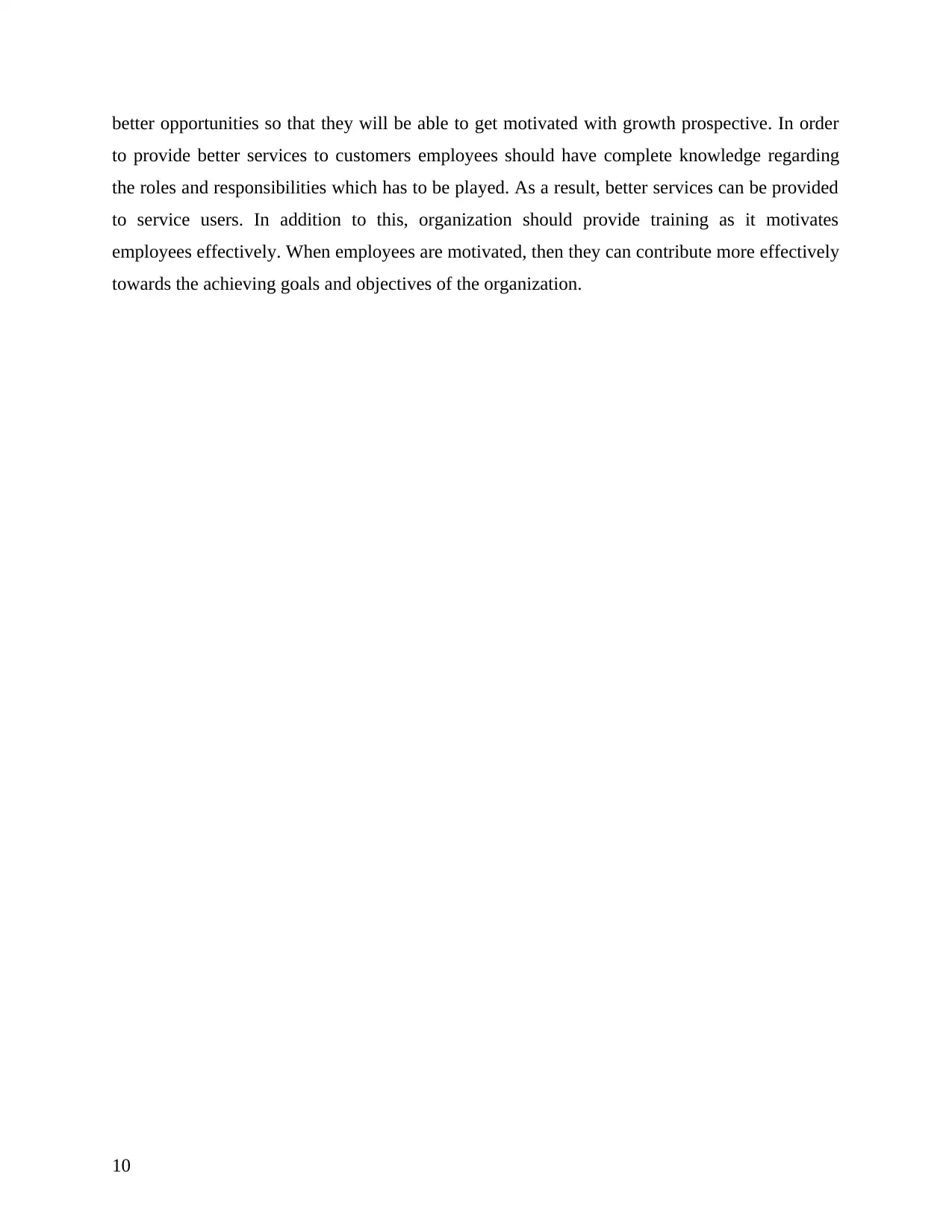
better opportunities so that they will be able to get motivated with growth prospective. In order
to provide better services to customers employees should have complete knowledge regarding
the roles and responsibilities which has to be played. As a result, better services can be provided
to service users. In addition to this, organization should provide training as it motivates
employees effectively. When employees are motivated, then they can contribute more effectively
towards the achieving goals and objectives of the organization.
10
to provide better services to customers employees should have complete knowledge regarding
the roles and responsibilities which has to be played. As a result, better services can be provided
to service users. In addition to this, organization should provide training as it motivates
employees effectively. When employees are motivated, then they can contribute more effectively
towards the achieving goals and objectives of the organization.
10
Paraphrase This Document
Need a fresh take? Get an instant paraphrase of this document with our AI Paraphraser
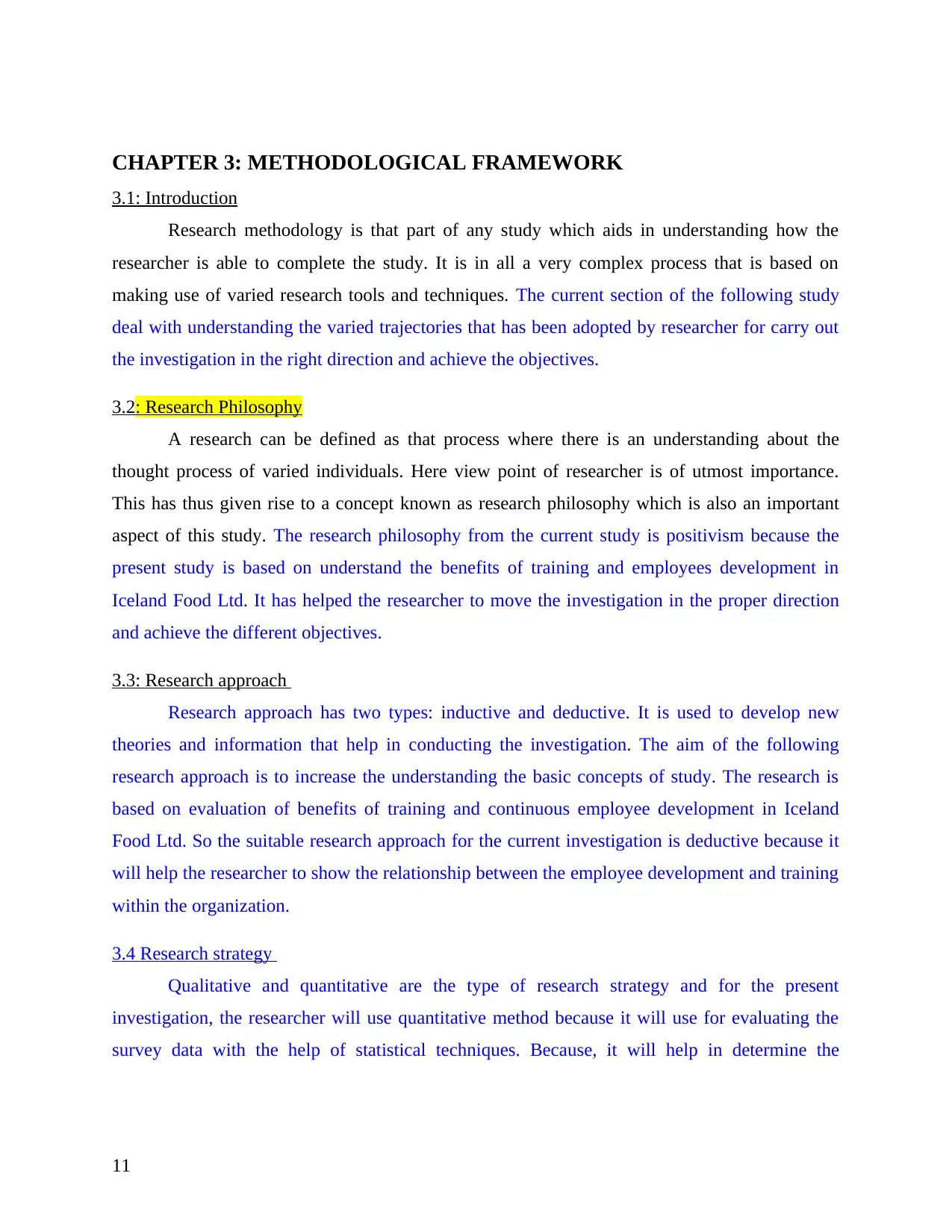
CHAPTER 3: METHODOLOGICAL FRAMEWORK
3.1: Introduction
Research methodology is that part of any study which aids in understanding how the
researcher is able to complete the study. It is in all a very complex process that is based on
making use of varied research tools and techniques. The current section of the following study
deal with understanding the varied trajectories that has been adopted by researcher for carry out
the investigation in the right direction and achieve the objectives.
3.2: Research Philosophy
A research can be defined as that process where there is an understanding about the
thought process of varied individuals. Here view point of researcher is of utmost importance.
This has thus given rise to a concept known as research philosophy which is also an important
aspect of this study. The research philosophy from the current study is positivism because the
present study is based on understand the benefits of training and employees development in
Iceland Food Ltd. It has helped the researcher to move the investigation in the proper direction
and achieve the different objectives.
3.3: Research approach
Research approach has two types: inductive and deductive. It is used to develop new
theories and information that help in conducting the investigation. The aim of the following
research approach is to increase the understanding the basic concepts of study. The research is
based on evaluation of benefits of training and continuous employee development in Iceland
Food Ltd. So the suitable research approach for the current investigation is deductive because it
will help the researcher to show the relationship between the employee development and training
within the organization.
3.4 Research strategy
Qualitative and quantitative are the type of research strategy and for the present
investigation, the researcher will use quantitative method because it will use for evaluating the
survey data with the help of statistical techniques. Because, it will help in determine the
11
3.1: Introduction
Research methodology is that part of any study which aids in understanding how the
researcher is able to complete the study. It is in all a very complex process that is based on
making use of varied research tools and techniques. The current section of the following study
deal with understanding the varied trajectories that has been adopted by researcher for carry out
the investigation in the right direction and achieve the objectives.
3.2: Research Philosophy
A research can be defined as that process where there is an understanding about the
thought process of varied individuals. Here view point of researcher is of utmost importance.
This has thus given rise to a concept known as research philosophy which is also an important
aspect of this study. The research philosophy from the current study is positivism because the
present study is based on understand the benefits of training and employees development in
Iceland Food Ltd. It has helped the researcher to move the investigation in the proper direction
and achieve the different objectives.
3.3: Research approach
Research approach has two types: inductive and deductive. It is used to develop new
theories and information that help in conducting the investigation. The aim of the following
research approach is to increase the understanding the basic concepts of study. The research is
based on evaluation of benefits of training and continuous employee development in Iceland
Food Ltd. So the suitable research approach for the current investigation is deductive because it
will help the researcher to show the relationship between the employee development and training
within the organization.
3.4 Research strategy
Qualitative and quantitative are the type of research strategy and for the present
investigation, the researcher will use quantitative method because it will use for evaluating the
survey data with the help of statistical techniques. Because, it will help in determine the
11
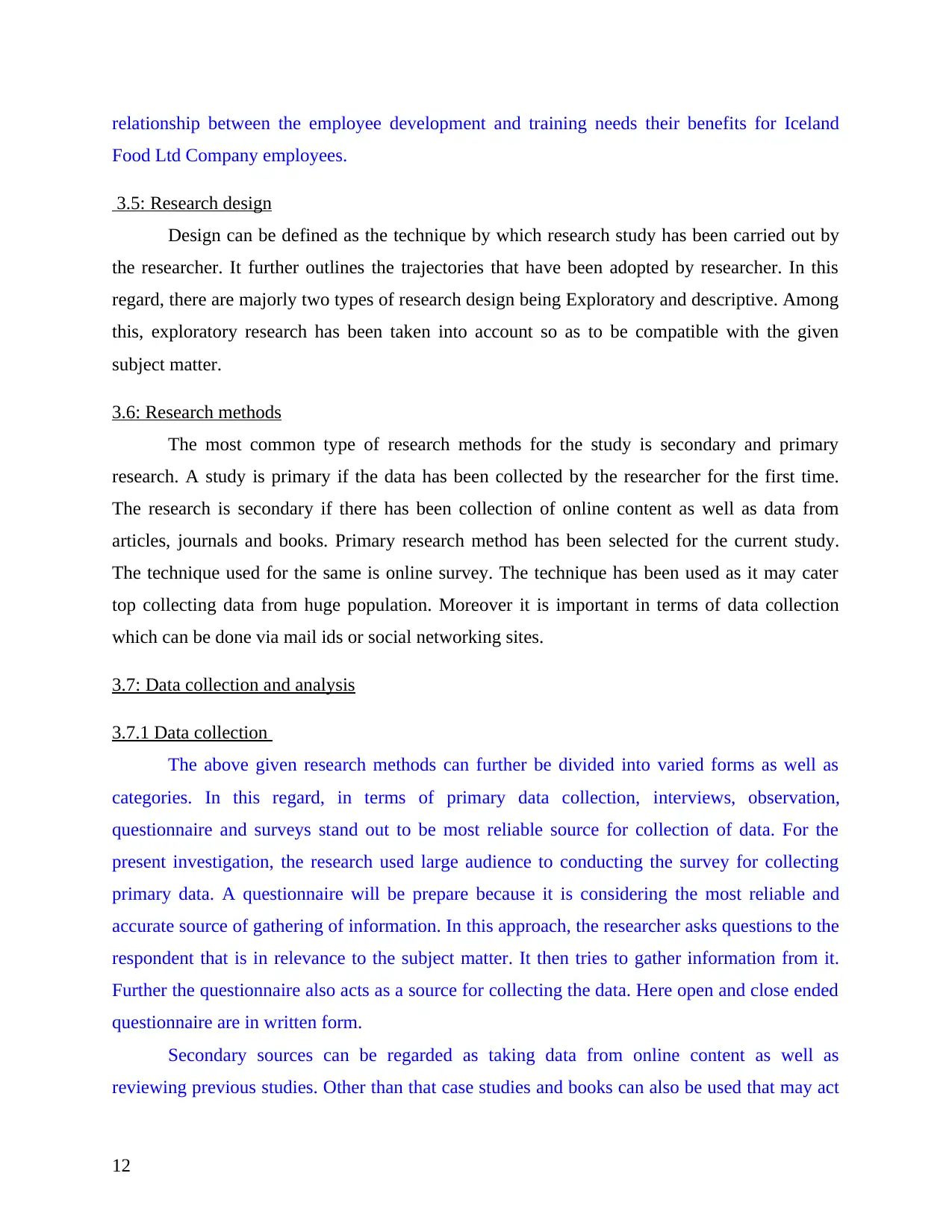
relationship between the employee development and training needs their benefits for Iceland
Food Ltd Company employees.
3.5: Research design
Design can be defined as the technique by which research study has been carried out by
the researcher. It further outlines the trajectories that have been adopted by researcher. In this
regard, there are majorly two types of research design being Exploratory and descriptive. Among
this, exploratory research has been taken into account so as to be compatible with the given
subject matter.
3.6: Research methods
The most common type of research methods for the study is secondary and primary
research. A study is primary if the data has been collected by the researcher for the first time.
The research is secondary if there has been collection of online content as well as data from
articles, journals and books. Primary research method has been selected for the current study.
The technique used for the same is online survey. The technique has been used as it may cater
top collecting data from huge population. Moreover it is important in terms of data collection
which can be done via mail ids or social networking sites.
3.7: Data collection and analysis
3.7.1 Data collection
The above given research methods can further be divided into varied forms as well as
categories. In this regard, in terms of primary data collection, interviews, observation,
questionnaire and surveys stand out to be most reliable source for collection of data. For the
present investigation, the research used large audience to conducting the survey for collecting
primary data. A questionnaire will be prepare because it is considering the most reliable and
accurate source of gathering of information. In this approach, the researcher asks questions to the
respondent that is in relevance to the subject matter. It then tries to gather information from it.
Further the questionnaire also acts as a source for collecting the data. Here open and close ended
questionnaire are in written form.
Secondary sources can be regarded as taking data from online content as well as
reviewing previous studies. Other than that case studies and books can also be used that may act
12
Food Ltd Company employees.
3.5: Research design
Design can be defined as the technique by which research study has been carried out by
the researcher. It further outlines the trajectories that have been adopted by researcher. In this
regard, there are majorly two types of research design being Exploratory and descriptive. Among
this, exploratory research has been taken into account so as to be compatible with the given
subject matter.
3.6: Research methods
The most common type of research methods for the study is secondary and primary
research. A study is primary if the data has been collected by the researcher for the first time.
The research is secondary if there has been collection of online content as well as data from
articles, journals and books. Primary research method has been selected for the current study.
The technique used for the same is online survey. The technique has been used as it may cater
top collecting data from huge population. Moreover it is important in terms of data collection
which can be done via mail ids or social networking sites.
3.7: Data collection and analysis
3.7.1 Data collection
The above given research methods can further be divided into varied forms as well as
categories. In this regard, in terms of primary data collection, interviews, observation,
questionnaire and surveys stand out to be most reliable source for collection of data. For the
present investigation, the research used large audience to conducting the survey for collecting
primary data. A questionnaire will be prepare because it is considering the most reliable and
accurate source of gathering of information. In this approach, the researcher asks questions to the
respondent that is in relevance to the subject matter. It then tries to gather information from it.
Further the questionnaire also acts as a source for collecting the data. Here open and close ended
questionnaire are in written form.
Secondary sources can be regarded as taking data from online content as well as
reviewing previous studies. Other than that case studies and books can also be used that may act
12
⊘ This is a preview!⊘
Do you want full access?
Subscribe today to unlock all pages.

Trusted by 1+ million students worldwide
1 out of 20
Related Documents
Your All-in-One AI-Powered Toolkit for Academic Success.
+13062052269
info@desklib.com
Available 24*7 on WhatsApp / Email
![[object Object]](/_next/static/media/star-bottom.7253800d.svg)
Unlock your academic potential
Copyright © 2020–2025 A2Z Services. All Rights Reserved. Developed and managed by ZUCOL.





